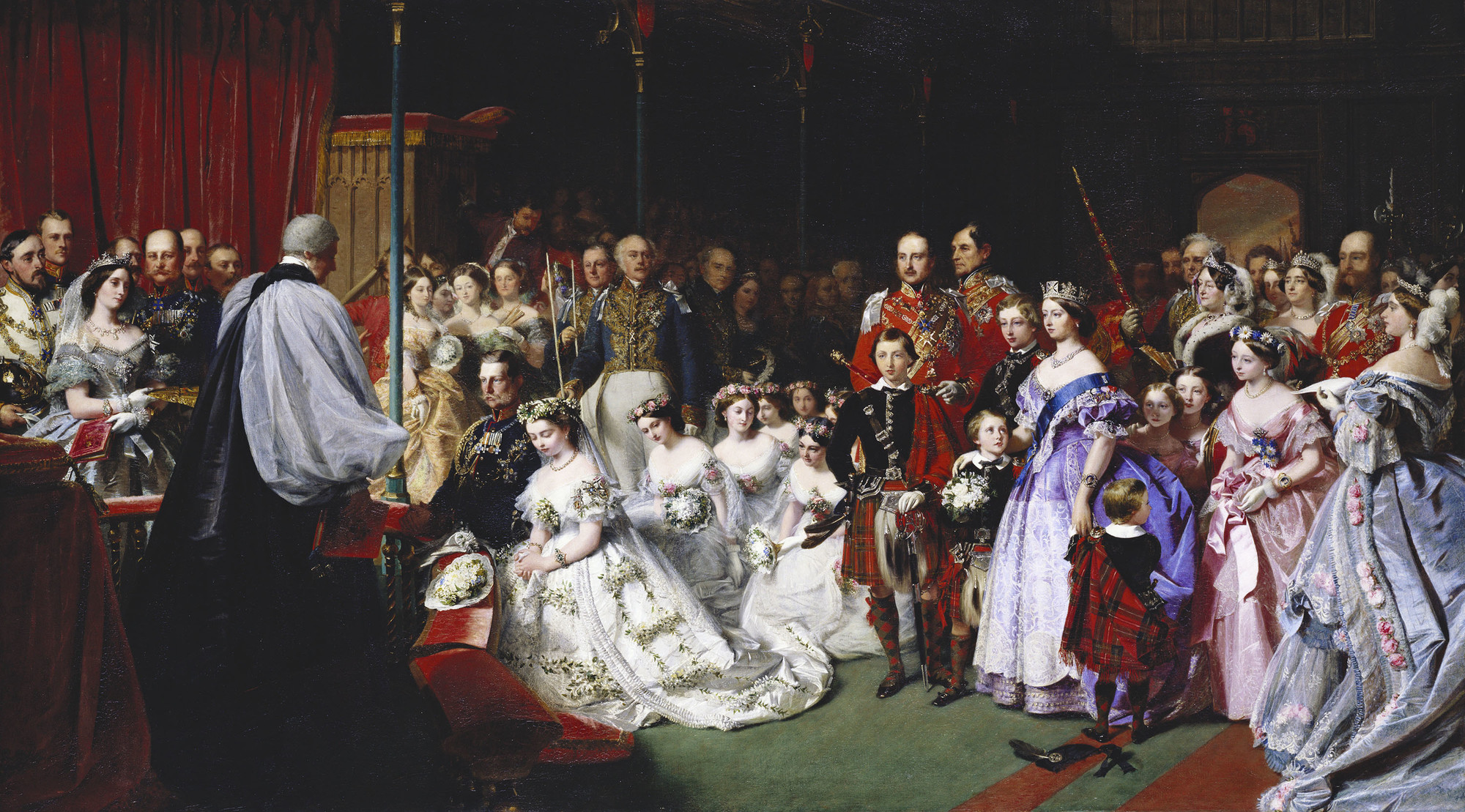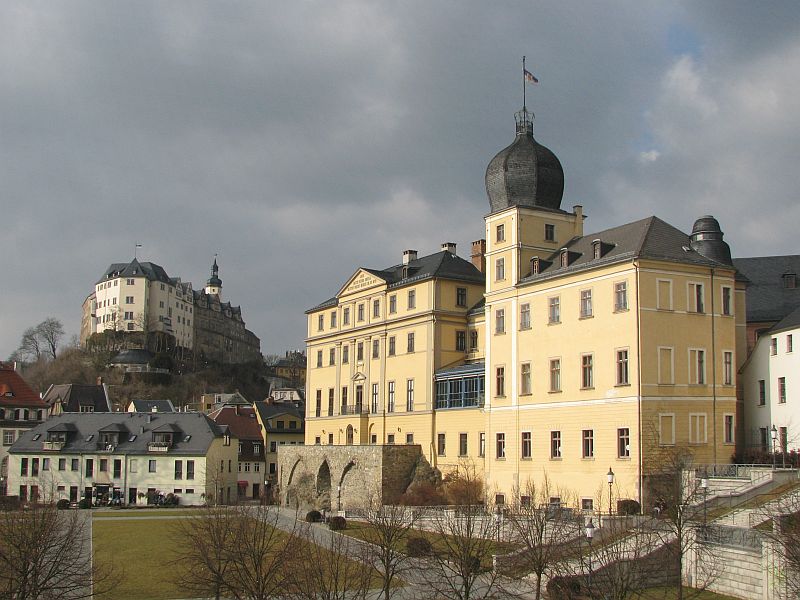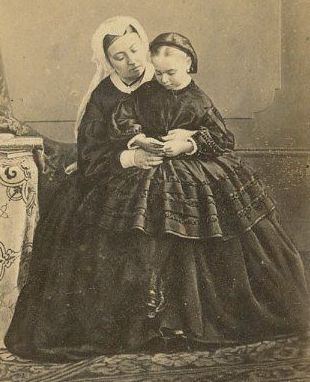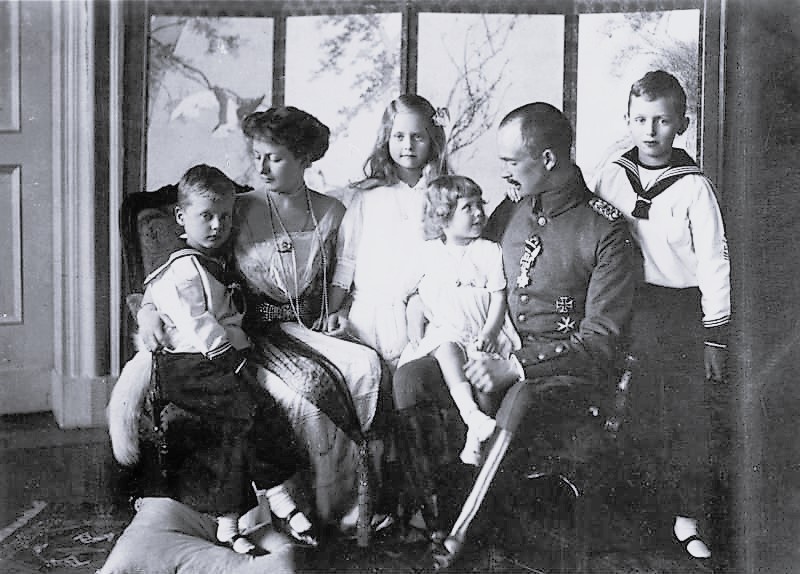by Susan Flantzer
© Unofficial Royalty 2019

The Marriage of Victoria, Princess Royal, 25 January 1858 by John Phillip; Credit – Royal Collection Trust/ © His Majesty King Charles II
Victoria, Princess Royal married Prince Friedrich of Prussia, the future Friedrich III, German Emperor and King of Prussia, at the Chapel Royal of St. James’s Palace in London, England on January 25, 1858. The couple had eight children and the Greek, Prussian, Romanian, Serbian, and Spanish royal families descended from this marriage.
Victoria’s Early Life

Queen Victoria with her eldest child Victoria, Princess Royal circa 1845; Credit – Wikipedia
The eldest of the nine children and the eldest of the five daughters of Queen Victoria of the United Kingdom and Prince Albert of Saxe-Coburg and Gotha was born on November 21, 1840, at Buckingham Palace, nine months after her parents’ marriage. Named Victoria after her mother and called Vicky in the family, she was created Princess Royal shortly before her first birthday.
Vicky started learning French with a French tutor when she was eighteen months old and then began learning German at age three. Later, Vicky studied science, literature, Latin, and history. All Vicky’s governesses and tutors were impressed with her intelligence.
Once Vicky was engaged to be married to her Prussian prince, her father Prince Albert personally taught her politics and modern European history and had her write essays about events in Prussia. Prince Albert and Queen Victoria ardently hoped that Vicky’s marriage would make the ties between London and Berlin closer and lead to a unified and liberal Germany. However, once married and in Prussia, Vicky and her husband were politically isolated, and their liberal and Anglophile views clashed with the authoritarian ideas of the Minister-President of Prussia, Otto von Bismarck.
For more about Vicky, see Unofficial Royalty: Victoria, Princess Royal, German Empress, Queen of Prussia
Friedrich’s Early Life

Friedrich, circa 1841; Credit – Wikipedia
The future Friedrich III, German Emperor, King of Prussia was born at the Neues Palais in Potsdam, Kingdom of Prussia, now in Brandenburg, Germany on October 18, 1831. The elder of the two children of the future Wilhelm I, German Emperor, King of Prussia and his wife Augusta of Saxe-Weimar-Eisenach, he was given the names Friedrich Wilhelm Nikolaus Karl but was known in the family as Fritz. His younger sister Louise married Friedrich I, Grand Duke of Baden.
Fritz received both a military and a classical education. He studied history, geography, physics, music, and religion. He had a talent for foreign languages, becoming fluent in English and French, and also studying Latin. Naturally, Fritz studied the traditional Hohenzollern areas of fencing, riding, gymnastics, and practical craft skills such as carpentry, book printing, and bookbinding. In addition, he also received a military education. Fritz interrupted his military training at the age of 18 to study history, politics, law, and public policy at the University of Bonn. His time at the University of Bonn helped solidify his liberal, reforming beliefs.
For more about Fritz, see Friedrich III, German Emperor, King of Prussia
The Engagement

Photograph taken at Balmoral to mark the Princess Royal’s engagement to Prince Friedrich of Prussia on September 29, 1855; From left to right: Prince Friedrich of Prussia, The Princess Royal, Prince Alfred (seated on the grass), Princess Alice, Princess Helena, Queen Victoria, Princess Louise, Prince Albert and The Prince of Wales; Credit – Photograph by George Washington Wilson, The Royal Collection Trust
In 1851, Prince Wilhelm of Prussia (the future Wilhelm I, King of Prussia and German Emperor) and his wife Augusta were invited to London by Queen Victoria to visit the Great Exhibition in Hyde Park, which her husband Prince Albert was instrumental in organizing. Wilhelm and Augusta brought their two children, 20-year-old Friedrich and 13-year-old Louise. On a visit to the Great Exhibition, nine-year-old Vicky was allowed to accompany the group as a companion to Louise. Despite being so young, Vicky made an impression on Friedrich (Fritz), who was eleven years older.
Four years later, in 1855, Fritz was invited back to England by Victoria and Albert for a visit to their Scottish home Balmoral. The British and Prussian royal families expected Fritz and Vicky to decide if they would marry. Fritz was second in line to the Prussian throne after his father, who was expected to succeed his childless brother. Even though a marriage would not be universally popular in either country, Vicky and Fritz agreed to marry each other. They became engaged on September 29, 1855, but the engagement was not publicly announced until May 17, 1856. Because Vicky was so young, her parents decreed that the wedding would have to wait until Vicky was 17 years old.
The Wedding Site
It was and still is, customary for the wedding to be in the bride’s home territory, but Vicky was marrying a future monarch and the wedding was therefore expected to be in Berlin in the Kingdom of Prussia. However, Queen Victoria had other ideas: “The assumption of it being too much for a Prince Royal of Prussia to come over to marry the Princess Royal of Great Britain in England is too absurd, to say the least…Whatever may be the usual practice of Prussian Princes, it is not every day that one marries the eldest daughter of the Queen of England. The question must therefore be considered as settled and closed…” Queen Victoria got her way and the wedding was scheduled for Monday, January 25, 1858, in the Chapel Royal of St. James’ Palace in London, England, where the bride’s parents had been married.
Located in St. James’ Palace, a Tudor palace in London next to Clarence House and nearby Buckingham Palace, the Chapel Royal was built around 1540 and has had alterations over the years. Although St. James’ Palace is no longer used as one of the monarch’s residences, it is used for offices and receptions, and several minor members of the British Royal Family have apartments there. The Chapel Royal in St. James’ Palace was the venue for several earlier Hanover weddings, including the wedding of Vicky’s parents. The Chapel Royal seats about 100 people so Vicky and Fritz’s wedding was nowhere near the size of today’s royal weddings. Accordingly, the guest list had to be limited.
Partial List of Wedding Guests

Queen Victoria, Prince Albert and Victoria, Princess Royal; Credit – Wikipedia
The above photograph is a daguerreotype taken just before the wedding. The figure of Queen Victoria is blurred due to her movement. Of the event, Queen Victoria wrote in her journal, “Vicky was daguerreotyped in my room, & she & her dear father & I, together, but I trembled so that it has come out indistinct. Then, it was time to go.”
The guest list below was gleaned from the New York Times re-publication on February 12, 1858 of the London Times’ article “The Royal Wedding – The Marriage of The Princess Royal – Graphic and Detailed Description of the Ceremonies”, published on January 26, 1858. It is most likely an incomplete guest list.
Royal Guests – The Bride’s Family
- Queen Victoria, mother of the bride
- The Prince Consort, father of the bride
- Duchess of Kent, grandmother of the bride
- Prince of Wales, brother of the bride
- Prince Alfred, brother of the bride
- Prince Arthur, brother of the bride
- Prince Leopold, brother of the bride
- Princess Alice, sister of the bride
- Princess Helena, sister of the bride
- Princess Louise, sister of the bride
- Prince George, 2nd Duke of Cambridge, first cousin once removed of the bride
- Duchess of Cambridge, great-aunt of the bride
- Princess Mary Adelaide of Cambridge, first cousin once removed of the bride
- Leopold I, King of the Belgians, great-uncle of the bride
- Prince Leopold of Belgium, Duke of Brabant, first cousin once removed of the bride
- Prince Philippe of Belgium, Count of Flanders, first cousin once removed of the bride
- Ernst II, Duke of Saxe-Coburg and Gotha, uncle of the bride
- Ernst, 4th Prince of Leiningen, half first cousin of the bride
- Prince Victor of Hohenlohe-Langenburg, half first cousin of the bride
Royal Guests – The Groom’s Family
- Prince and Princess Wilhelm of Prussia, parents of the groom
- Prince Adalbert of Prussia, first cousin once removed of the groom
- Prince Friedrich Karl of Prussia, first cousin of the groom
- Prince Albrecht of Prussia, uncle of the groom
- Friedrich I, Grand Duke of Baden, brother-in-law of the groom
- Prince Edward of Saxe-Weimar-Eisenach, first cousin once removed of the groom
Other Royal Guests
- Henri d’Orléans, Duke of Aumale and Maria, Carolina, Duchess d’Aumale
- Robert, Duke of Chartres
- Karl Anton, Prince of Hohenzollern-Sigmaringen
- Helen, Duchess of Orléans
- Philippe, Count of Paris
- Clementina, Princess of Salerno
- Prince Julius of Schleswig-Holstein-Sonderburg-Glücksburg
Other Guests
- George Campbell, 8th Duke of Argyll
- George Murray, 6th Duke of Atholl
- Walter Montagu Douglas Scott, 5th Duke of Buccleuch
- William Montagu, 7th Duke of Manchester
- Henry Pelham-Clinton, 5th Duke of Newcastle
- Charles Gordon-Lennox, 5th Duke of Richmond and Caroline Gordon-Lennox, Duchess of Richmond
- Elizabeth Wellesley, Duchess of Wellington
- Henry Petty-Fitzmaurice, 3rd Marquess of Lansdowne
- Louisa Hamilton, Marchioness of Abercorn
- Elizabeth Campbell, Marchioness of Breadlebane
- Harriet de Burgh, Marchioness of Clanricarde
- Edward Smith-Stanley, 14th Earl of Derby and Emma Smith-Stanley, Countess of Derby
- Charles Yorke, 4th Earl of Hardwicke and Susan Yorke, Countess of Hardwicke
- Caroline Ponsonby, Countess of Bessborough
- Marie Louise Leveson-Gower, Countess Granville
- Sophie Child Villiers, Countess of Jersey
- Caroline Edgcumbe, Countess of Mount Edgcumbe
- Laura Phipps, Countess of Mulgrave
- Susan Stapleton-Cotton, Viscountess Cumbermere
- Emily Townshend, Viscountess Sydney
- Edward Stanley, 2nd Baron Stanley of Alderley and Henrietta Stanley, Baroness Stanley of Alderley
- John Campbell, 1st Baron Campbell and his wife Mary Elizabeth Campbell, 1st Baroness Stratheden
- Robert Grosvenor, 1st Baron Ebury and Charlotte Grosvenor, Baroness Ebury
- Fox Maule-Ramsay,2nd Baron Panmure and Montague Maule-Ramsay, Baroness Panmure
- Henry Labouchere, 1st Baron Taunton
- Sir George Cornewell Lewis, 2nd Baronet and Lady Cornewell Lewis
- Lord Alfred Paget, Queen Victoria’s Chief Equerry and Clerk Marshal, and Lady Paget
- Sir George Grey and Lady Grey
- Sir Charles and Lady Mary Wood
- Lord and Lady Ernest Bruce
- Mr. Vernon Smith
- Matthew Talbot Baines, Chancellor of the Duchy of Lancaster and Mrs. Baines
Procession Participants
Among the procession participants in The Queen’s Procession, The Bridegroom’s Procession and The Bride’s Procession at the Chapel Royal were:
- The Earl Marshal: Henry Fitzalan-Howard, 14th Duke of Norfolk
- Prime Minister and First Lord of the Treasury: Henry John Temple, 3rd Viscount Palmerston
- Treasurer of the Household: George Phipps, Earl of Mulgrave
- Comptroller of the Household: Valentine Browne, 4th Earl of Kenmare
- Lord Chamberlain of the Household: John Campbell, 2nd Marquess of Breadalbane
- Keeper of the Privy Purse: Colonel The Honourable Sir Charles Beaumont Phipps
- The Lord Steward: Edward Granville Eliot, 3rd Earl of St Germans
- Lord Privy Seal: Dudley Ryder, 2nd Earl of Harrowby
- Lord President of the Council: Granville Leveson-Gower, 2nd Earl Granville
- Lord High Chancellor: Robert Rolfe, 1st Baron Cranworth
- Mistress of the Robes: Harriet Sutherland-Leveson-Gower, Duchess of Sutherland
- Lady of the Bedchamber: Frances Jocelyn, Viscountess Jocelyn
- Groom of the Stole to The Prince Consort: James Hamilton, 2nd Marquess of Abercorn
- Chief Equerry and Comptroller of the Household of The Duchess of Kent: Sir George Couper, 2nd Baronet
- Train Bearer for The Duchess of Kent: Lady Anna Maria Dawson, daughter of John Dawson, 1st Earl of Portarlington
- Lady-in-Waiting to Princess Augusta, Duchess of Cambridge: Lady Geraldine Somerset, daughter of Henry Somerset, 7th Duke of Beaufort
- Train Bearer for The Duchess of Cambridge: Lady Arabella Sackville-West, daughter of
- George Sackville-West, 5th Earl De La Warr
- Baron Otto Theodor von Manteuffel, Minister-President of the Kingdom of Prussia
Supporters and Bridesmaids

Victoria, Princess Royal’s, bridesmaids 1887 copy after an original of 25 Jan 1858 Hughes & Mullins: Ryde, Isle of Wight (photographer); Credit – Royal Collection Trust From left to right, Lady Cecilia Gordon-Lennox, Lady Susan Pelham-Clinton, Lady Katherine Hamilton, Lady Emma Stanley, Lady Constance Villiers, Lady Susan Murray, Lady Cecilia Molyneux, and Lady Victoria Noel
Fritz was supported by his father Prince Wilhelm of Prussia (the future Wilhelm I, German Emperor and King of Prussia) and his uncle Prince Albrecht of Prussia.
Vicky had had eight bridesmaids, all of whom were unmarried daughters of British Dukes and Earls:
- Lady Cecilia Gordon-Lennox (1838-1910), daughter of Charles Gordon-Lennox, 5th Duke of Richmond, married Charles Bingham, 4th Earl of Lucan
- Lady Susan Pelham-Clinton (1839-1875), daughter of Henry Pelham-Clinton, 5th Duke of Newcastle, married Lord Adolphus Vane-Tempest
- Lady Katherine Hamilton (1840-1874), daughter of James Hamilton, 1st Duke of Abercorn, married William Edgcumbe, 4th Earl of Mount Edgcumbe
- Lady Emma Stanley (1835-1928), daughter of Edward Stanley, 14th Earl of Derby, married Sir Wellington Patrick Chetwynd-Talbot
- Lady Constance Villiers (1840-1922), daughter of George Villiers, 4th Earl of Clarendon, married Frederick Stanley, 16th Earl of Derby
- Lady Susan Murray (1837-1915), daughter of Alexander Murray, 6th Earl of Dunmore, married James Carnegie, 9th Earl of Southesk
- Lady Cecilia Molyneux (1838-1910), daughter of Charles Molyneux, 3rd Earl of Sefton, married Hugh Dawnay, 8th Viscount Downe
- Lady Victoria Noel (1839-1916), daughter of Charles Noel, 1st Earl of Gainsborough, married Sir Thomas Buxton, 3rd Baronet
The Wedding Attire

Victoria, Princess Royal in her wedding dress; Credit – https://www.royal.uk/wedding-dresses
Vicky’s wedding dress was made of white moire antique (a textile with a wavy appearance), trimmed with Honiton lace and orange flowers and myrtle. The train, carried by the eight bridesmaids, was also made of white moire antique lined with satin bordered with white satin ribands, Honiton lace, orange flowers, and myrtle. Vicky wore a wreath of orange flowers and myrtle and a veil of Honiton lace on her head. The Honiton lace in the dress, train, and veil consisted of bouquets in openwork of the rose, shamrock, and thistle in three medallions. The rose, the shamrock, and the thistle are the national flowers of England, Ireland, and Scotland. Vicky wore a diamond necklace, diamond earrings, and a diamond brooch. On her left sleeve, Vicky wore the Order of Louise, a Prussian order of chivalry created by King Friedrich Wilhelm III of Prussia in honor of his late wife, born Louise of Mecklenburg-Strelitz, and the Royal Order of Victoria and Albert.

Close-up detail of The Marriage of Victoria, Princess Royal, 25 January 1858 by John Phillip; Credit – Royal Collection Trust/ © Her Majesty Queen Elizabeth II
Fritz wore the General’s uniform of the Prussian First Infantry Regiment of the Guard – a dark blue tunic with gold embroidery on the collar and cuffs, a gold aiguillette (ornamental tagged cord or braid) on the right shoulder, a silver sash, and white kerseymere (a fine woolen cloth with a fancy twill weave) trousers.
The Wedding Ceremony
Embed from Getty Images
Queen Victoria and her family at the wedding, engraved from the painting by John Philip
Eighteen carriages and 300 soldiers were in the procession for the short ride from Buckingham Palace to St. James’ Palace. Queen Victoria and Vicky were in the very last carriage. They were met at St. James’ Palace by Prince Albert and King Leopold I of the Belgians, the uncle of both Victoria and Albert. Vicky’s four brothers were in Highland dress and the elder two (Bertie and Alfred) preceded the Queen down the aisle. Vicky’s two younger brothers (Arthur and Leopold) accompanied their mother down the aisle followed by three of Vicky’s four sisters (Alice, Helena, and Louise), dressed in white lace over pink satin. Beatrice, Vicky’s youngest sibling, was left back at Buckingham Palace as she was not even a year old. Next came Fritz, accompanied by his father and his uncle Prince Albrecht of Prussia. Finally, Vicky came down the aisle escorted by her father Prince Albert and her great-uncle Leopold I, King of the Belgians.
John Sumner, Archbishop of Canterbury, conducted the service and he was so nervous that he left out several parts of the service. However, Queen Victoria was pleased that both “Vicky and Fritz spoke plainly,” as she wrote in her journal. The service was concluded with George Friedrich Handel’s Hallelujah Chorus and then Vicky and Fritz led the recessional to The Wedding March by Felix Mendelssohn (click to listen). Thereafter, it became a popular wedding recessional. The music is from a suite of incidental music to Shakespeare’s play A Midsummer Night’s Dream. Queen Victoria loved Mendelssohn’s music and he often played for her while on his visits to the United Kingdom. The bride and groom along with Queen Victoria and the princes and princesses then proceeded to the Throne Room of St. James’ Palace where the marriage certificate was signed in the presence of the clergy who participated in the ceremony.
The Wedding Luncheon
Embed from Getty Images
‘A National Toast’, 1858. ‘Health and Happiness to the Bride and Bridegroom! (Hoorah!)’. Mr. Punch, as the People’s representative, raises a foaming glass of champagne to celebrate the marriage of Victoria, Princess Royal, to Prince Friedrich of Prussia. From Punch, or the London Charivari, January 30, 1858. (Photo by The Cartoon Collector/Print Collector/Getty Images)
Vicky and Fritz led the carriage procession back to Buckingham Palace. Back at the palace, Queen Victoria, The Prince Consort, the newlyweds, the British royal family, and the foreign princes and princesses walked from the Picture Gallery to the State Dining Room where a luncheon was served.
The elaborate wedding cake was placed in the middle of the table. It was seven or eight feet high and was divided into three parts from top to bottom. The upper part had two cupids holding a medallion with portraits of Vicky and Fritz. The middle part consisted of niches containing statutes including ones of Innocence and Wisdom. The bottom part had medallions of vases and baskets of flowers.
Other guests including the Officers of State, the Ladies and Gentlemen of the Households of The Queen and The Prince Consort, and other important guests had luncheon in the Lower Dining Room at Buckingham Palace.
After luncheon, Vicky and Fritz appeared on the Buckingham Palace balcony with and without their parents.
The Honeymoon and Leaving England

Vicky and Fritz on January 29, 1858; Credit – Wikipedia
After the wedding luncheon, the newly married couple left by train for a two-day honeymoon at Windsor Castle. Upon arrival at Windsor, Vicky and Fritz were met by fireworks, cannons, an honor guard, and cheering crowds. Schoolboys from nearby Eton pulled their carriage from the train station up the hill to Windsor Castle.
The next day, Vicky and Fritz went on a walk and went ice skating. Family members and members of the wedding party arrived at Windsor Castle two days after the wedding. Queen Victoria wrote in her diary that it was quite strange to see Vicky walking off with Fritz at bedtime.
On January 29, 1858, everyone returned to London for more festivities before Vicky and Fritz left for Prussia. On her last day at home, February 1, 1858, Vicky spent a quiet day with her mother and then spent the early evening playing with her nine-month-old sister Beatrice. Vicky confided to her mother, “I think it will kill me to take leave of dear Papa.”
On the day of Vicky’s departure, Queen Victoria described the scene in her diary: “We went into the Audience Room where Mama & all the Children were assembled & here poor Vicky and Alice’s, as well as the other’s tears began to flow fast…The Hall was filled with all our people and theirs [the Prussians]…amongst the many servants there. Poor dear child…I clasped her in my arms…kissed good Fritz…Against the door of the carriage, I embraced them both…What a dreadful moment, what a real heartache to think of our dearest child being gone & not knowing how long it may be before we see her again!”
Vicky and Fritz, accompanied by her father, her two oldest brothers Bertie and Affie, and her mother’s uncle The Duke of Cambridge drove to Gravesend where they were to board the royal yacht for the voyage to the European continent. As they reached the yacht, Bertie and Affie cried and Vicky sobbed as she said goodbye to her father, who somehow maintained his composure. The next day, Prince Albert wrote his daughter a letter: “My heart was very full when yesterday you leaned your forehead on my breast to give free vent to your tears. I am not of a demonstrative nature and therefore you can hardly know how dear you have always been to me, and what a great void you have left behind in my heart.”
Embed from Getty Images
The departure of The Princess Royal to Germany, circa January 1858. (Photo by Popperfoto via Getty Images/Getty Images)
Children

Vicky, Fritz and their children; Credit – Wikipedia
Vicky and Fritz had eight children:
- Wilhelm II, German Emperor and King of Prussia (1859-1941) married (1) (1881) Princess Augusta Victoria of Schleswig-Holstein-Sonderburg-Augustenburg (1858-1921), had seven children, Greek and Spanish Royal Families descend from this marriage; married (2) (1922) Princess Hermine of Reuss (1887-1947), no children
- Princess Charlotte of Prussia (1860-1919) married (1878) Bernhard III, Duke of Saxe-Meiningen (1851-1928), had one child
- Prince Heinrich of Prussia (1862-1929) married (1888) Princess Irene of Hesse and by Rhine (1866-1953), a grandchild of Queen Victoria, had three children
- Prince Sigismund of Prussia (1864-1866), died young from meningitis
- Princess Viktoria of Prussia (1866-1929), married (1) (1890) Prince Adolf of Schaumburg-Lippe (1859-1917), no children; married (2) (1927) Alexander Zoubkoff (1901-1936), no children
- Prince Waldemar of Prussia (1868-1879), died young from diphtheria
- Princess Sophie of Prussia (1870-1932), married (1889) King Constantine I of Greece (1868-1923), had six children, Greek, Romanian, Serbian, and Spanish Royal Families descend from this marriage
- Princess Margarete of Prussia (1872-1954), (1893) married Prince Friedrich Karl of Hesse (1868-1940), had six children
This article is the intellectual property of Unofficial Royalty and is NOT TO BE COPIED, EDITED, OR POSTED IN ANY FORM ON ANOTHER WEBSITE under any circumstances. It is permissible to use a link that directs to Unofficial Royalty.
Works Cited
- Flantzer, Susan. (2015). Friedrich III, German Emperor, King of Prussia. [online] Unofficial Royalty. Available at: https://www.unofficialroyalty.com/friedrich-iii-german-emperor-king-of-prussia/ [Accessed 15 Aug. 2019].
- Flantzer, Susan. (2015). Victoria, Princess Royal, German Empress, Queen of Prussia. [online] Unofficial Royalty. Available at: https://www.unofficialroyalty.com/victoria-princess-royal-german-empress-queen-of-prussia/ [Accessed 15 Aug. 2019].
- Pakula, Hannah. (1995). An Uncommon Woman. New York: Simon & Shuster.
- Timesmachine.nytimes.com. (1858). The Royal Wedding – The Marriage of The Princess Royal – Graphic and Detailed Description of the Ceremonies,. [online] Available at: https://timesmachine.nytimes.com/timesmachine/1858/02/12/78528860.pdf [Accessed 15 Aug. 2019].
- Van der Kiste, John. (2013). Dearest Vicky, Darling Fritz. Stroud: The History Press.
- Victoria and Ramm, Agnes. (1998). Beloved & Darling Child. Stroud, Gloucestershire: Sutton Pub.
























































